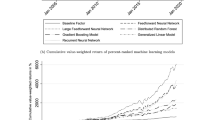Abstract
Not so long ago the international financial markets were being acclaimed as the cure-all for debt crises and interest rate and exchange rate risks, but new developments are giving increasing cause for concern, as the Deutsche Bundesbank1 noted recently. Pessimists are spreading a mood of disaster and are already predicting the collapse of the world financial system.2 What is the basis for such fears? How serious is the danger of a crash?
Similar content being viewed by others
o|
Neue, nicht-bilanzwirksame Finanzinstrumente und ihre Bedeutung fur die Kreditinstitute in der Bundesrepublik in Monatsberichte der Deutschen Bundesbank, Vol 39, No 4 April 1987 pp 23–27
See for example Deregulierung kam zu hastig und unuberlegt, in Handelsblatt, 20–21 3 1987
See Federal Reserve Bank of New York Annual Report 1986
See also A R Dombret Securitization, in Zeitschrift fur das gesamte Kreditwesen, No 8, 1987, pp 326–330
See G Evans Why New Products Come and Go in Financial Innovations Made to Measure, Supplement to Euromoney, January 1987, pp 2 19
In this connection and generally, see A R Dombret, op cit, p 328 Adetailed description of the various instruments is to be found in Bank for International Settlements Recent Innovations in International Banking, Basle April 1986
See D. Wermuth, W. Ochynski: Strategien an den Devisenmärkten, Wiesbaden 1984, pp. 154 ff. In fact, in an interest rate swap the principal of the loans is not swapped, but each party merely takes over the interest payment commitments of the other. See G. Eilenberger: Wahrungsmanagement und Devisenkurssicherung, Frankfurt am Main 1986, pp. 175 ff.
See Bank for International Settlements, op. cit., p. 10.
See D. Wermuth, W. Ochynski, op. cit., pp. 132 ff. In contrast to the classification used in the article, Wermuth and Ochynski regard only interest rate contracts as financial futures and deal with currency futures separately.
For details, see Bank for International Settlements, op. cit., pp. 61 ff.
Ibid., pp. 189 ff.
See the example of currency options, in D. Sondermann: Kurssicherungsverfahren: Hedgen von Optionen, in: W. Krelle (ed.): Ökonomische Prognose-, Entscheidungs- und Gleichgewichts-modelle, Weinheim 1986, p. 134.
See Bank for International Settlements, op. cit., p. 195.
For example, where there is a risk of changes in interest rates, it is not always easy to decide whether an interest rate futures contract will provide protection or which would be best. See M. Desmond Fitzgerald: Financial Futures, London 1983, pp. 89 ff. Currency options are another example; the seller of a European option might conclude a forward transaction as a hedge in the belief that the option was highly likely to be exercised at maturity, only to find that the reverse was the case the next day because of changing conditions in the foreign exchange markets, so that he was left with an open forward position that now itself bore an exchange risk.
See also Merril Stevenson: A Game of Skill as Well, in: The Economist, 21st March 1987, International Banking Survey, pp. 4ff.
In Germany financial innovations such as Euro-note facilities have begun to be subject to banking supervision since the third amendment of the Banking Law in 1986. See also Ulrike Dennig: Die Deregulierung des internationalen Finanzsystems seit 1975, to be published in: Hamburger Jahrbuch für Wirtschafts- und Gesellschaftspolitik, Vol. 32 (1987).
For details on this and subsequent points, see Federal Reserve Bank of New York, op. cit., pp. 15 f.
Merril Stevenson, op. cit., p. 4.
Ibid, pp. 3 f.
See for example the essays in Forrest Capie, Geoffrey E. Wood (eds.): Financial Crises and the World Banking System, London 1986; Charles P. Kindleberger: Manias, Panics, and Crashes, New York 1978, has now become a standard work on the subject.
On this and subsequent points, see also Anna J. Schwartz: Real and Pseudo-financial Crises, in: Forrest Capie, Geoffrey E. Wood (eds.), op.cit., pp. 11 ff.
See also Anna J. Schwartz, op. cit., p. 11.
Ibid., p. 28.
Author information
Authors and Affiliations
Rights and permissions
About this article
Cite this article
Reszat, B. Financial markets at the crossroads: Fears of a great crash. Intereconomics 22, 211–215 (1987). https://doi.org/10.1007/BF02933530
Issue Date:
DOI: https://doi.org/10.1007/BF02933530




